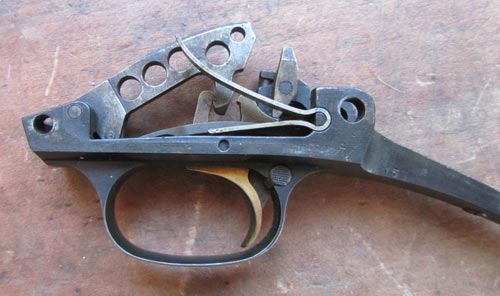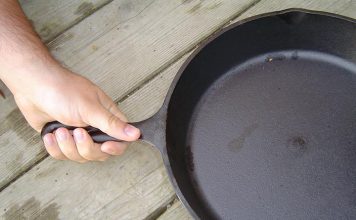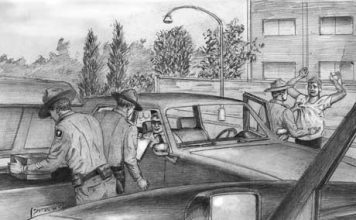| Website Exclusive • September, 2014 |

A 1958 “Light Twelve” Browning Auto-5, with a 28″ Improved Cylinder barrel and ‘Speedfeed’ loading. It weighs less than 7½ pounds, balances nicely, and the stock dimensions suit many people well.
I’m a double-barrel kind of shotgun guy, but there’s one autoloader that strikes my fancy: the Browning Auto-5. Named because it holds four rounds in the magazine plus one in the chamber, it’s a well-made, rugged, true classic from the days of milled steel and hand-checkered walnut. No stampings, no aluminum, no plastic. Unlike many more modern guns built in the Age of Lawyers, it tends to have a decent trigger. It was designed by the Michelangelo of firearms, John Moses Browning who called it his “best achievement” in 1898. That’s the year the USS Maine exploded in Havana Harbor and the Spanish-American War began. William McKinley was President and Teddy Roosevelt led the Rough Riders up San Juan Hill. An automobile speed record of 39 m.p.h. was set, and Will Kellogg invented Corn Flakes.
The Auto-5 remained in production for the next century. There’s a bewildering assortment of models, not to mention copies like the Remington Model 11, Savage 720, Franchi AL48, and a variety of Japanese knock-offs. There was even a Russian counterfeit. But there’s no need to bother with clones. A couple million of the real things were made.
You can buy a used Auto-5 for a fraction of the price of the latest-and-greatest, alloy-and-plastic autos that are introduced every year. And it’ll still be chugging along after most of those are lost in the mist of history. With minimal care, you can use it hard and then pass it down for several more generations of hard use. “Planned obsolescence” was not part of the Auto-5’s design philosophy. They have the life expectancy of redwood trees.
This article will narrowly focus on what I think is both the pinnacle and the bargain of the lot: lightweight Belgian-made 12-gauge guns with 2¾” chambers, crossbolt safeties and “Speedfeed” loading. As of this writing (April 2014), they can consistently be found in very good working order in the $400 to $600 range. (Expect prices to increase as inflation continues to devalue our currency. Unlike our dollar, however, the Auto-5 will retain its value.) Parts are readily available, and will be for a long time.
Pictured above is my most recent score, an unmodified 1958 in great shape from a local shop for $425. It functions flawlessly. There is some handling wear as you’d expect after 56 years, but it appears to have been carried more than it was fired. A firearm deserves to be thoroughly cleaned every half century, so a complete disassembly was the project of a recent weekend. There were some remarkable accumulations of gunk here and there inside the receiver I even found a pine needle but not much wear at all. Everything was lightly lubricated before reassembly. The Auto-5 is not one of those firearms that likes to run “wet,” and oil-soaked wood is the cause of a lot of problems. Besides, modern lubricants are so superior to what was available a century ago that a little goes a long way. Remember, this is a gun that hit the market years before Ford’s Model A.
There were some areas where the bluing was worn, and some surface freckles of rust. I scrubbed these with fine steel wool and touched up with Brownell’s Oxpho-Blue.
The stock was stripped with Citristrip. The walnut underneath the old, yellowed, and peeling high-gloss varnish was dense, straight-grained, and workmanlike. The forend had a small crack where it butted up against the receiver. I soaked it in acetone to remove all the oil from the wood, and filled the crack with expanding urethane glue. All the wood was then refinished with tung oil. The inside of the stock was also completely sealed. One of these days when I remember where I put my checkering tools I’ll get around to recutting the checkering.

The buttstock before refinishing.

The buttstock after refinishing.
The buffalo horn buttplate had some worm holes, as they often do. My wife is appalled, but I like the added character. I soaked it in mineral oil for a few hours and was pleasantly surprised at how it came back to life.
The Auto-5 uses the force of recoil to cycle the action. When a shot is fired, both the barrel and bolt are pushed to the rear of the receiver, then returned to the firing position by springs think “Pogo stick.” The mechanism is optimized for specific ammunition by appropriately arranging a bronze “friction piece” and a steel “friction ring” in conjunction with the recoil spring. If you unscrew the magazine cap and slide the forend off the magazine tube of a used gun to look at these pieces, they are very likely to be set up incorrectly. This has given the Auto-5 an undeserved reputation for being a “hard kicker.” In reality, it’s just the opposite. Just follow the directions in the manual, and it’ll work fine and be a pleasure to shoot. Manuals are available from Browning for free download on their website. (www.browning.com)
The Auto-5 was produced by the Belgian firm Fabrique Nationale (FN) beginning in 1902. Browning introduced the “Light Twelve” variation, with additional milling of barrel and receiver to reduce weight, in 1946. The left side of their receivers are engraved with the words “Light Twelve.” The original so-called “suicide safety” inside the trigger guard was changed to a conventional “crossbolt” button at the rear of the trigger guard in the early 1950s.
“Speedfeed” was introduced in the mid 1950s. It’s a useful feature that automatically chambers the first round inserted into the magazine if the bolt is locked to the rear. You’ll appreciate it when you’ve run the magazine dry and ducks are still dropping into the decoys. There was a change in the design of the carrier spring in 1957. It doesn’t matter much, but just to keep all mine consistent for disassembly and reassembly, I stick to 1958s and later.

The trigger group is representative of the quality of Auto-5s: nothing but milled steel. No stampings, no plastic, no aluminum. Firearms like this are simply no longer economically feasible to produce.
Production of the Auto-5 was moved to Japan in 1976. The Japanese iterations are strong and well-made. Many are rated for use with steel shot. But they lack such refinements as hand checkering and engraving. Their bluing is more black than blue. Worse, they weigh considerably more than the Belgians. So much so that the lightweight Japanese models are heavier than the standard weight Belgians.
So, the bottom line is to look for guns made from the late ’50s through 1975. The lightweights will have a “G” in the serial number. If there are one or two numbers preceding the G, that’s the year of manufacture. e.g., 8Gxxxx is a lightweight manufactured in 1958. 73Gxxxx is a lightweight manufactured in 1973.
As you prowl the gunshops, you’ll see a disheartening number of guns damaged by neglect (i.e. rust), by firing steel shot (look for a slight ring before the choke constriction), and “home gunsmithing.” You’ll see shortened butts, aftermarket recoil pads, oil-soaked wood, drilled and tapped holes, etc. You’ll see missing screws and “gorilla’d” screws. I once saw one with a very amateurish eagle carved into the stock, and recently one with an unfitted recoil pad attached with drywall screws. You’ll also see a lot of forends with cracks towards the rear. Often these can be or have been repaired. Worst of all are the barrels with adjustable choke devices installed. Those abominations were all the rage a few decades ago. They don’t work well, and to add insult to injury, they look like someone stuck a plum on the muzzle. The “compensator” types with integral ports purported to reduce recoil are ear-splittingly loud.
If you peruse online auction sites like Gunbroker, you’ll find scores of Auto-5s. Pay attention to what they’re actually selling for, not just what some people are asking. In the past few days, a couple all-original guns in decent condition have sold for about $500. At the other end of the spectrum is a listing for a gun with a poorly refinished stock, a pitted receiver, and an adjustable choke device with a starting price of $850. There’s another in nice condition but with a shortened stock and a starting price of $900. Caveat emptor. Watch the listings and be patient.

The recoil mechanism is optimized for specific shotshell loads by the arrangement of these parts: recoil spring, steel friction ring, and bronze friction piece. If recoil feels more severe than it should, or if the action fails to cycle properly, then the friction ring, friction piece, and recoil spring are almost certainly set up wrong. Be sure to follow the directions in the operating manual. The mechanism on top is set up for heavy loads, and the mechanism on the bottom is set up for light loads. Either way, the beveled edge of the bronze friction piece always goes towards the muzzle, and the flat edge of the steel friction ring always goes against the recoil spring.
Once you’ve found a Light Twelve made in Belgium with a crossbolt safety and the Speedfeed feature, condition is everything. Don’t be tempted by the false economy of “bargains” with unsalvageable stocks and ruined barrels. Of course, both of those things can be easily replaced, but not inexpensively. Be prepared for sticker shock. A factory replacement buttstock and forend set with plain-figured wood is $350, almost the price of a good used gun. A replacement barrel will probably be more, if you can even find one. So many barrels have been ruined over the decades that even if someone were to give you a nice complete action, bringing it back to life with wood and a barrel would probably set you back at least $700, not to mention your time.
If an aftermarket recoil pad has been installed, the value of the gun is decreased by about a third. Perhaps you won’t mind a pad if you just want a shooter and the gun is otherwise in great condition. If the barrel has been cut or modified with one of the aforementioned adjustable choke devices, it’s a half-price gun, even if the dealer pretends he doesn’t know it. Good luck putting it back to rights if you decide to buy it anyway.
Ventilated ribs on barrels increase prices by $100-$200, although the Auto 5’s geometry obviates any need for them. Once you raise the stock to your cheek, you can’t see anything but the bead over that distinctive square-stern receiver anyway. A raised rib on an Auto-5 barrel is a silly affectation. Ventilated ribs only add unwanted weight (about four ounces) and collect debris. They’re susceptible to damage, too. Solid ribs just add weight. I’ve sold my barrels with raised ribs, and kept only plain and “matte rib” barrels. “Matte rib” is what Browning called a chicken-scratch pattern engraved on the top of a plain barrel, ostensibly to reduce glare. It probably doesn’t actually do much, but it’s an attractive touch that shows the attention to detail that went into the manufacture of even workmanlike guns once upon a time.
Chokes are indicated by symbols stamped into the barrel, as follows:
- Full *
- Improved Modified *-
- Modified **
- Improved Cylinder **-
- Skeet **S-
- Cylinder ***
Full chokes seem to be most common. Modern ammunition patterns far better than the paper-hulled shells of the Auto-5’s glory days, so unfortunately you’ll probably be overchoked for most applications with one.
24″ smooth-bore slug barrels with cylinder chokes and rifle sights are also relatively common. They work well with Foster-type slugs. The Hastings company used to make good quality 24″ rifled barrels for saboted slugs, and those occasionally come up for sale, too. The Auto-5 isn’t at its best as a slug gun, though. Since there is no solid connection between the receiver and the barrel, only barrel-mounted open sights are practical. If you want peep sights or optics, other guns are better options.
Short barrels are fine for turkey guns, which are aimed and fired like rifles, and for riot guns, which are made for close-quarters combat, but they don’t swing well on bird guns. You’ll be better served by a 28″ or longer barrel rather than a 26″. If you come across such a barrel in good condition with an improved cylinder or modified choke, don’t think twice about snapping it up. More than once I’ve bought guns just because I wanted the barrel. If you end up with more barrels than you need, the extras are easy to resell on Ebay or Gunbroker.

Later model crossbolt safety
The Auto-5’s operating system requires a certain minimum mass for the barrel, so the shortest factory barrel made was the 24″ “Buck Special” slug barrel. It’s a bit more unwieldy than the usual 18-20″ barrels on modern “riot guns,” but an Auto-5 would still be an awesome home defense weapon. Magazine extensions are available, but if you can’t solve your problem with 5 stone-cold reliable rounds of buckshot, it’s probably not going to get solved with two or three more, either. I stopped using after-market magazine extensions after one came apart under recoil and launched itself, all my ammo, and the spring and follower downrange.
Do not use steel shot in Belgian-made barrels. Unlike the later (and heavier) Japanese barrels, they weren’t engineered for it. There are alternative ammunition choices when lead shot isn’t appropriate. Bismuth and tungsten won’t damage your barrel and are more effective than steel, to boot. They’re expensive, but not as expensive as ruining an irreplaceable classic. Prices are coming down as economies of scale kick in, too.
If you need work done on an Auto-5, the best in the business is Art’s Gun Shop in Hillsboro, Missouri. Art has been kind enough to post helpful videos about the Auto-5 on his website, too. (www.artsgunshop.com)
If you want to do your own work beyond basic field stripping for cleaning, educate yourself and make sure you’re up to it. The guns are not engineered to be easily disassembled. Their screws have very narrow slots that most screwdrivers won’t fit specifically to discourage it. Don’t even think about touching them without a screwdriver bit kit from Brownells. Buggered screws make John Moses Browning cry.
Auto-5s are functional art. Enjoy the search for the right one, and enjoy caring for it and using it until you pass it down.















Fantastic article. Great leg work and details
I really enjoyed this article an learned a lot from it. I just picked up a 58 Light at a gun show yesterday for $450. Its in good shape overall. I thought that was a decent price. Interesting to learn about the differences in safety designs and the speedfeed function. Really glad I read all the way through because I didn’t even think about the issue of steel shot. Makes sense though.
Thanks,
Tim from MD